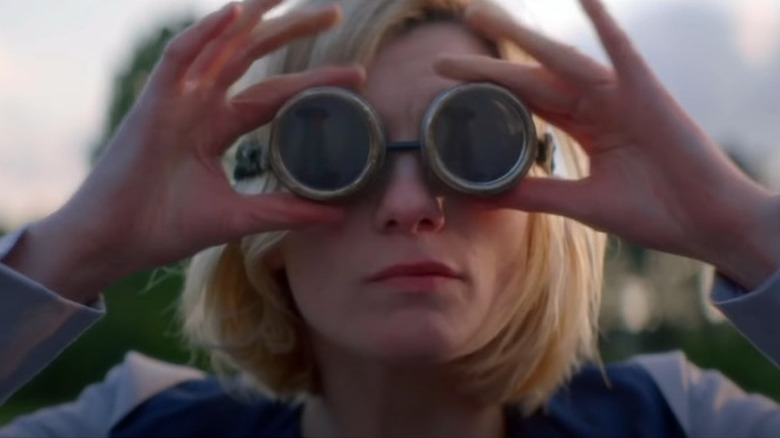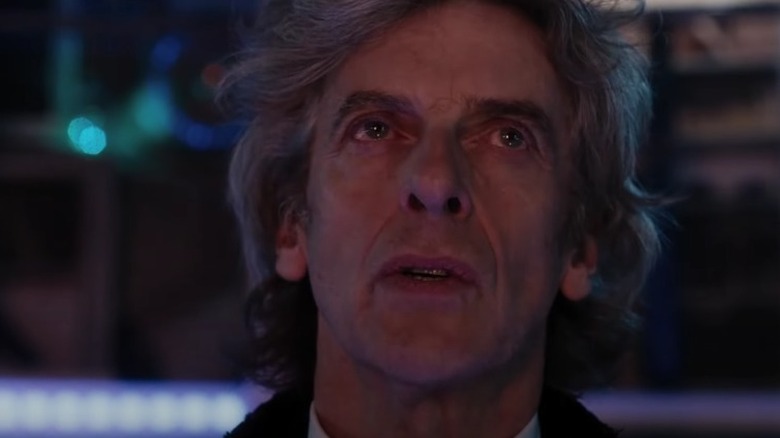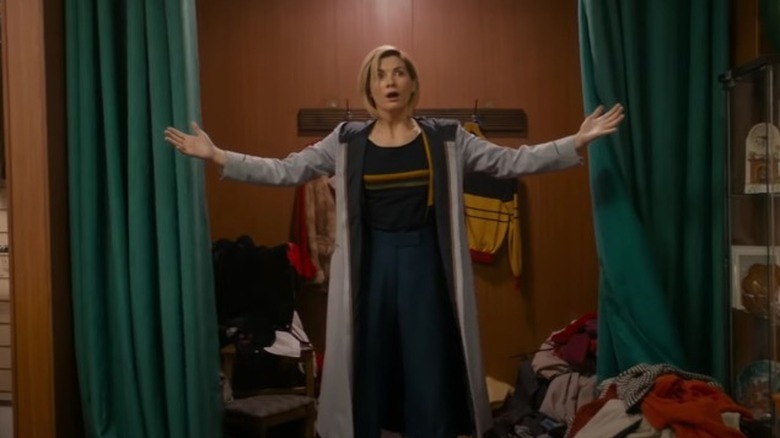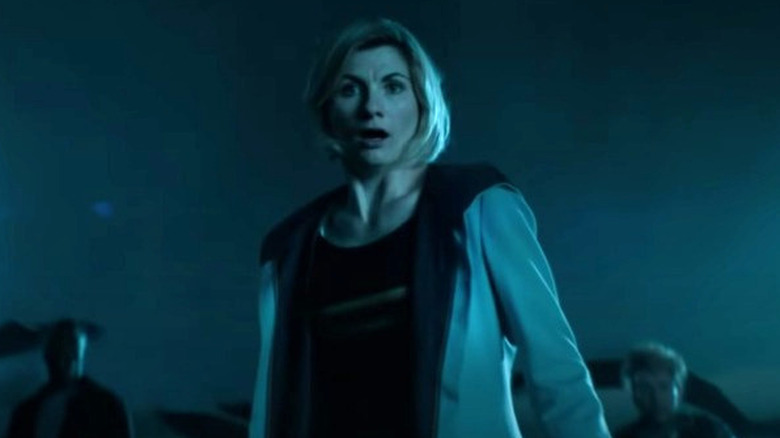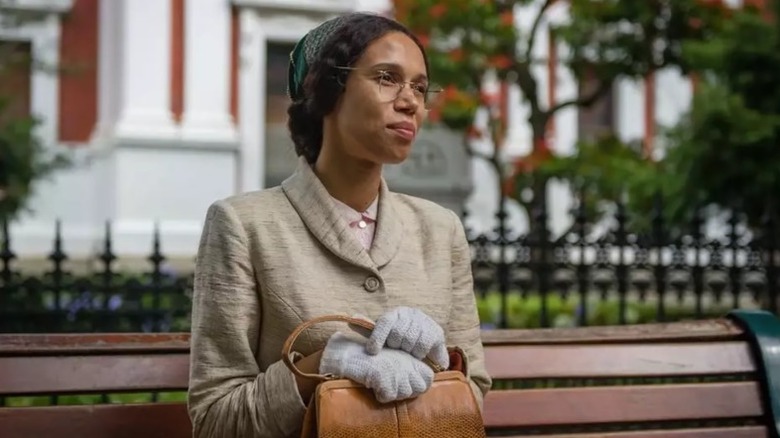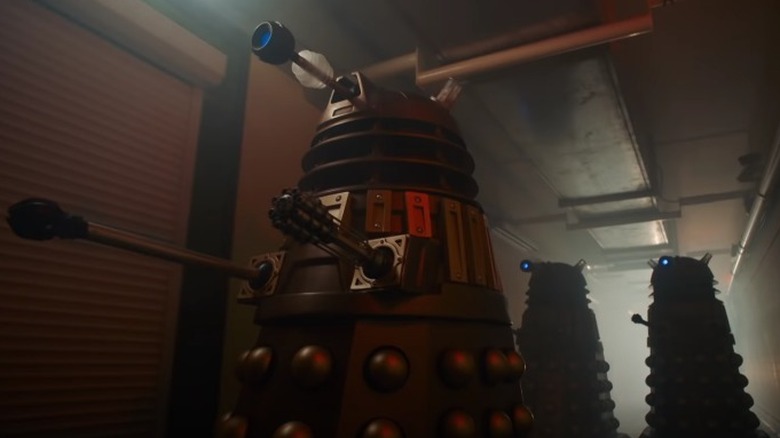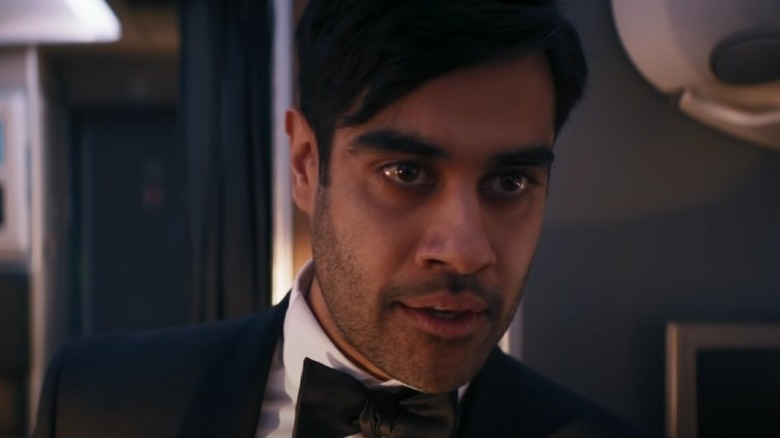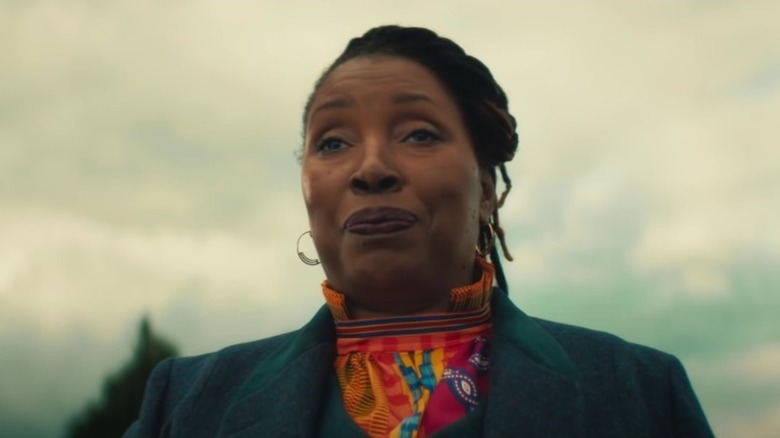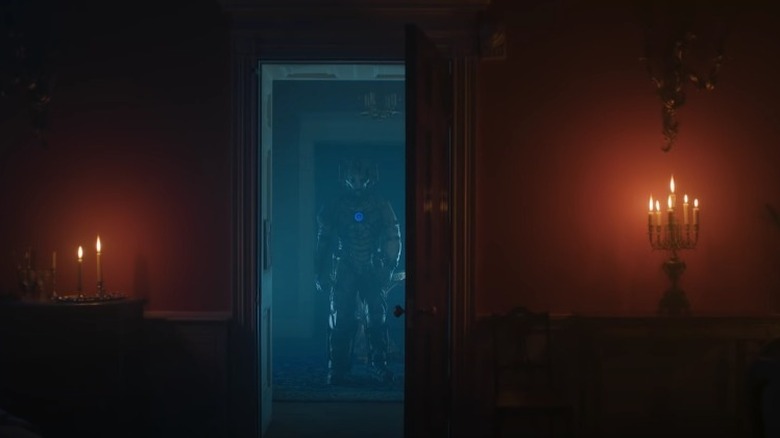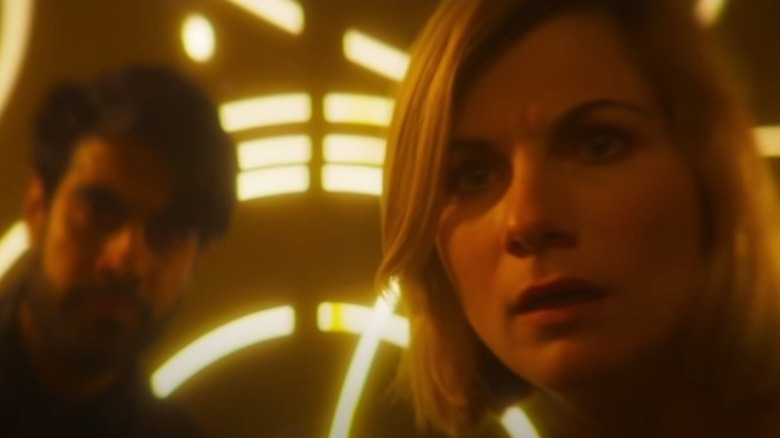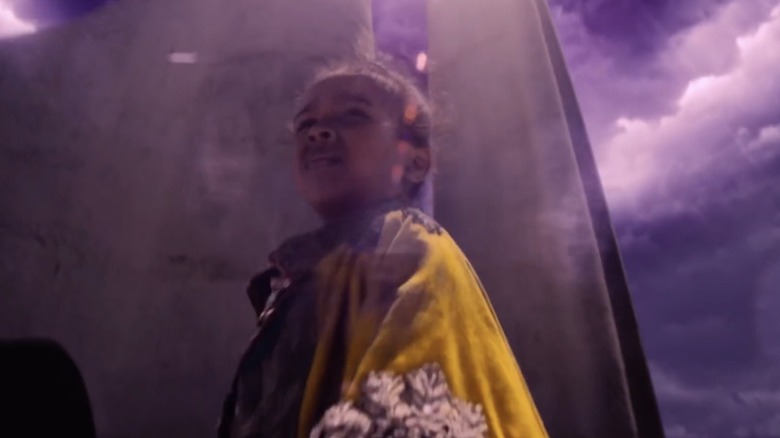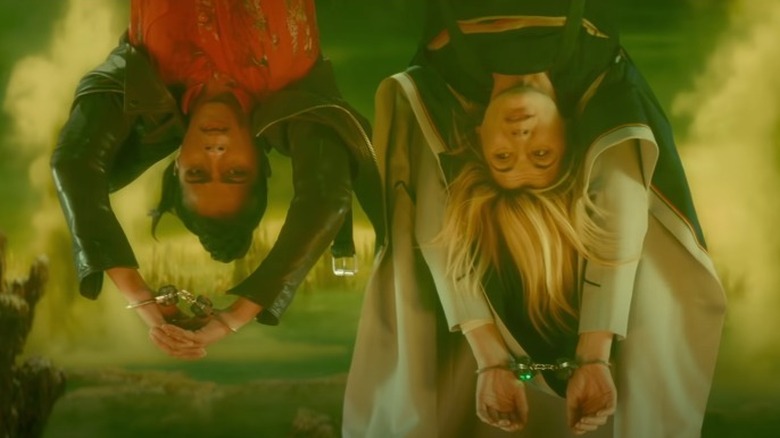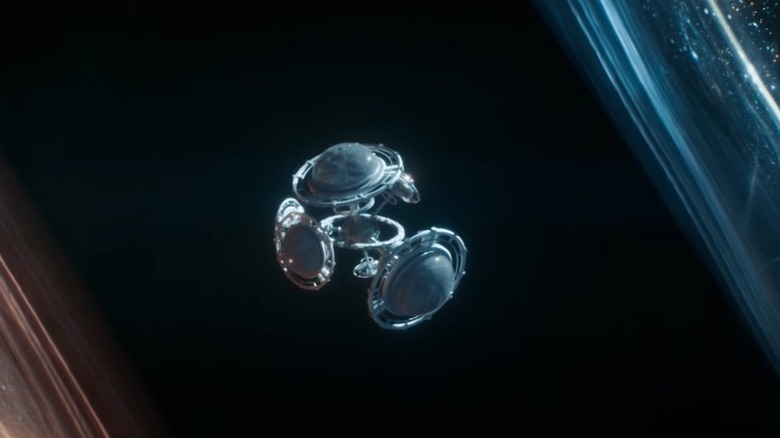The Complete Timeline Of The Thirteenth Doctor Explained
"Doctor Who" premiered in November of 1963. Since then, several actors have played the role, but the character does not start from scratch every time someone else takes the job. The Doctor is an alien who regenerates upon their evident demise; therefore, new actors are able to play the same character as those who've gone before while also reinterpreting and shaping it into something brand new.
Jodie Whittaker is (at time of writing) the most recent actor to star as the Doctor. While her tenure in the TARDIS is scheduled to come to a close before the end of 2022, we thought it would be worthwhile to look back on this time in the Doctor's impossibly long life and streamline as much of it as possible.
Instead of breaking down each episode and explaining every reference, we're talking about the big arcs of the Thirteenth Doctor's era to prepare for the final act of her story.
I Don't Want To Go
The Jodie Whittaker era begins with the end of Peter Capaldi's tenure as the Twelfth Doctor.
In the episode "The Doctor Falls," Capaldi's Doctor is badly wounded in his fight against the Cybermen, and his body begins the regeneration process. The only problem is that he doesn't want to go through with it. Although regeneration allows the Doctor to continue living, paradoxically, their current incarnation dies. As the Tenth Doctor explains in "The End of Time," "Even if I change, it feels like dying. Everything I am dies. Some new man goes sauntering away." Of course, that episode aired years before a woman signed on to officially play the Doctor.
So, the Twelfth Doctor initially isn't ready to let go. While refusing to regenerate, he runs into his first television incarnation, this time played by David Bradley. Over the course of their adventure together, both Doctors accept the necessity of regenerating. They go off to their individual TARDISES and allow their bodies to let go, allowing someone new to step forward.
With his beautiful final words, "Doctor, I let you go," the visage of Twelve burns away. Seconds later, we get a quick glimpse at the first woman to canonically play the Doctor, before she's thrown from her ship and falls to Earth.
The Doctor Falls To Earth
The Thirteenth Doctor's first story, "The Woman Who Fell to Earth," is a season premiere that essentially treats itself like the start of a new show. Most of the episode is devoted to explaining how future companions ("companion" being the unofficial term for ordinary humans who travel with the Doctor) Ryan Sinclair (Tosin Cole), his step-grandfather Graham (Bradley Walsh), and a former schoolmate of Ryan's named Yasmin Khan (Mandip Gill) meet a strange woman from outer space. It's an excellent entry point to "Doctor Who" for viewers who haven't seen the show before.
The Doctor's introduction in the story is a fantastic sight. As a sphere of hissing electrical wires makes its way through a stopped train, the Doctor (having recently fallen out of the TARDIS, which was in space at the time) comes crashing through the ceiling. Since her body is still regenerating, she's able to hop right back up, seemingly unharmed. The Doctor looks around, sees the big mess of alien electricity, and chases it away with a severed wire hanging from the ceiling.
The rest of the episode consists of the Doctor building a new sonic screwdriver while recalibrating from her regeneration and working out how to defeat the alien Tzim-Sha (a.k.a. Tim Shaw) with the help of her new friends. Ryan loses his grandmother in the struggle against Tzim-Sha, but the tragedy doesn't prevent him, or Graham and Yaz, from joining the Doctor on the trip of a lifetime through space and time.
The Timeless What?
In her second adventure, we get the first mention of what will go on to be this Doctor's defining arc.
While hunting for her missing TARDIS, the Doctor and her friends meet a pair of aliens competing in a race to reach what they call "the Ghost Monument" — a structure that fazes in and out of existence, found on a planet called Desolation. The Doctor joins this race, because the so-called "Ghost Monument" turns out to be her TARDIS.
During their journey, they encounter a species called the Remnants. Long story short, the Remnants are basically sheets capable of hunting and killing people; also, they can see into the Doctor's mind. The linen-like monsters accuse her of fearing her own newness, while also claiming they see more of her past than even she remembers.
"We see deeper, though, further back," they whisper. "The Timeless Child."
These words strike a nerve, and the Doctor asks them to elaborate. They say, "We see what's hidden, even from yourself — the outcast, abandoned and unknown." She has no idea what they're talking about, and circumstances force her to escape before she can find out. This the first time we're hearing about this so-called "Timeless Child," and it's a little incredible how close this apparently vague and cryptic dialogue comes to explaining the Timeless Child's whole deal.
Adventures In Space and Time
Jodie Whittaker's first season offers a strong balance of history-based stories and science fiction adventure. The episodes inspired by real-world global events do more than simply visit the past; these "Doctor Who" tales take the time to address some pretty heavy subject matter.
In "Rosa", the Doctor and her friends meet and protect American civil rights activist Rosa Parks (Vinette Robinson). In "Demons of the Punjab," Yaz meets her grandmother as a young woman, and the story explores how the partition of India tore families apart. "The Witchfinders" focuses on witch hunts, and includes a memorable performance from Alan Cumming as King James I.
The sci-fi side of the season gives us the adorable and dangerously ravenous Pting in "The Tsuranga Conundrum," deadly bubble wrap in "Kerblam!," and a final showdown with that pesky Tim Shaw in the season's final episode, "The Battle of Ranskoor Av Kolos."
All in all, it's a standard-quality season of "Doctor Who" with some definite bright spots, but nothing revolutionary or character-defining. All that is still to come.
New Year's Evil
Each Doctor has a moment where they stand up and remind their enemies (and their audience) just how powerful and frightening the Doctor can be.
For Jodie Whittaker's version, this moment arrives in the New Year's Eve special "Resolution." This episode includes a return to truly frightening Daleks when archeologists uncover an ancient scout Dalek that's been buried on Earth for hundreds of years. Much to the misfortunate of the archeologists, the creature returns to life and assumes control of a human woman, operating her like a puppet.
Not only does the Dalek use this poor woman's vocal cords to speak, but at one point in the episode, it laughs at the Doctor. This is unacceptable. Promptly following this vile cackling, the Doctor stares the creature down and brilliantly delivers a challenge that makes you throw your fist in the air.
"Now," she says, "Do that again to my face."
The Whittaker era includes three Dalek-related New Year's Eve specials. "Revolution of the Daleks" from 2019 continues the trend of making the Daleks more intimidating by showing us scenes of them coldly blasting people to death all over the place. The third installment, "Eve of the Daleks" from 2022, doesn't exactly offer a new take on the Daleks, but explores how horrendous it would be to be stuck in a time loop with robotic killing machines. These are some of the best episodes this era has to offer.
"O?" No! It's The Master
The Thirteenth Doctor's second season starts off with a bang in the form of "Spyfall, Part 1." MI6 taps the Doctor and her friends to help investigate the murders of several spies around the globe. To aid them in their research, the Doctor visits an agent named O (Sacha Dhawan) who is forced to live in Australia. Even though we've never seen this character before, the Doctor seems to know him, which makes him appear trustworthy.
The secret behind the assassinations isn't all that important in the grand scheme of "Doctor Who." O's true identity, on the other hand, is kind of a big deal.
While fleeing to safety, the Doctor notices O has trouble running. This doesn't sit right with her, as his file says he was a champion sprinter. Instead of continuing the lie, O comes clean. He is one of the Doctor's oldest adversaries – the Master, an evil Time Lord oft-considered the inverse of the apparently benevolent Time Lord, the Doctor.
In "Spyfall, Part 2," the Master chases the Doctor through time. She outsmarts him, of course, but he lets her know that he has destroyed Gallifrey, the Time Lord home planet. According to the Master, he discovered a secret so infuriating that, in his wrath, he killed everyone on the planet.
Why would he do this? He's not telling. He wants the Doctor to find out the truth the hard way, just like him.
Captain Jack and Ruth
"Fugitive of the Judoon" starts off as a standard adventure; space cops for hire, the Judoon, are searching Earth for a mysterious fugitive, and the Doctor steps in to intervene. The audience is left to assume the fugitive might be an apparently normal human woman named Ruth (Jo Martin). In the middle of the Doctor's efforts to figure out who this fugitive is, John Barrowman's Captain Jack Harkness — a fan favorite from all the way back in the Nineth Doctor's tenure – returns to "Doctor Who."
That would've been enough of a surprise by itself, but the episode isn't done with us yet. The Doctor and Ruth visit Ruth's childhood home, hoping something will jog her memory and reveal why the Judoon might be after her. While there, the Doctor comes across a blank gravestone. Digging below it, she discovers her TARDIS buried in the ground. She turns and sees Ruth, in a new Doctor-like outfit, standing with absolute confidence.
In one of the most flabbergasting reveals in the show's history, Ruth tells the Doctor that she remembers everything now, and the blue box in the ground is her ship. "Let me take it from the top," she says. "Hello. I'm the Doctor."
The Doctor running into time-displaced versions of themselves is nothing new. This time, though, neither Doctor recognizes the other. The secret behind the identity of this unknown incarnation of the Doctor is one of the final pieces in this era's biggest mystery.
The Lone Cyberman; or, The Origin of Frankenstein
The reason Captain Jack shows up in "Fugitive of the Judoon" is to warn the Doctor about a Lone Cyberman (Patrick O'Kane), and the importance of not giving him what he wants. This comes back up in a gothic history-inspired episode called "The Haunting of Villa Diodati," in which the Doctor and friends meet author Mary Shelley in the days leading up to the creation of Shelley's iconic novel, "Frankenstein; or, The Modern Prometheus."
"The Haunting of Villa Diodati" does for the Cybermen what "Resolution" did for the Daleks. This Lone Cyberman, in his broken armor exposing the man beneath, is hulking and menacing. He doesn't simply stomp around proclaiming that everyone will be deleted; he is constantly at war with his own humanity, struggling to keep it at bay until he can purge himself of his organic matter completely.
The Cyberman plans to do this with something called the Cyberium, which happens to have attached itself to Mary's husband, poet Percy Shelley. In order to save Percy (and reality itself), the Doctor goes against Jack's warning by removing the Cyberium and giving it to the Lone Cyberman, potentially dooming countless lives.
Into The Matrix
The goal of the Lone Cyberman is to resurrect the rest of the Cybermen with no organic components at all, making them perfect machines. While trying to prevent the Lone Cyberman from achieving his goal, the Doctor comes face to face with the Master once again. He brings her to the decimated remains of Gallifrey, ready to reveal everything he's learned and why he obliterated the Time Lords.
The Matrix — a supercomputer on with no connection to any other sci-fi franchise, despite its title — tracks the origins of the Time Lords all the way back to the Timeless Child, and shows the Doctor the true history of Gallifrey.
Before the Time Lords, the dominant species on Gallifrey was the Shobogans. One of their explorers, a woman named Tecteun (Seylan Baxter), discovered a doorway to another universe, with a child standing outside that doorway. Tecteun brought her back to Gallifrey and adopted her. After falling from a great height, the child almost died. At the last minute, her physical form changed completely. This was the first regeneration.
Fascinated, Tecteun experimented on the child for years, trying to understand regeneration. She finally managed to use her research to manipulate Shobogan DNA, granting them the ability to regenerate. Shobogans developed new technologies, built a citadel, and began calling themselves Time Lords.
The Master also discovered the identity of the Timeless Child ... the Doctor.
The Timeless Child
If the Timeless Child is the Doctor, then William Hartnell — the actor who originally played the character back in the 1960s — isn't the first in-story incarnation. As world-breaking as this may seem, there's actually a precedent for it.
The 1976 Tom Baker story "The Brain of Morbius" (no connection to Marvel's living vampire) suggests that other Doctors existed prior to Hartnell's version. We actually see a handful of them during a mental duel. It's never really commented on explicitly, but it's possible that "The Brain of Morbius" helped sow the seeds of what became the Timeless Child saga.
During the era of the Seventh Doctor, played by Sylvester McCoy, there are numerous hints that the Doctor's past is more mysterious than had previously been explored. These were attempts by script editor Andrew Cartmel to bring back an element of the unknown to the Doctor and are often referred to by fans as the Cartmel Masterplan.
Although the idea of a secret origin to the Doctor isn't exactly new, it makes the classic character infinitely more complex and mysterious. We know the Doctor's DNA created the Time Lords, but we have no idea where she came from, or how many of them existed. This frees up creators to craft entirely new Doctors and adventures without being beholden to the ones who've already appeared on screen. We now have more story possibilities than ever before, which is really saying something.
Here Comes The Flux
The Thirteenth Doctor's third season, sometimes advertised as "Doctor Who: Flux," takes a new approach. Instead of telling individual stories over the course of an entire season, there are six interconnected stories with a whole lot going on. Again, we're just going to focus on the Thirteenth Doctor's definitive storyline — the arc involving her past.
A wave of antimatter is devouring the universe, and the Doctor is trying to stop it. At the same time, two beings called Swarm (Sam Spruell) and Azure (Rochenda Sandall) are killing lots and lots of people. They come from the time in the Doctor's past that she doesn't remember. Specifically, this is the era when she was Ruth (from "Fugitive of the Judoon") and working for a Time Lord organization called Division alongside the Lupari Karvanista.
In those early days, Swarm was the Doctor's nemesis, until he was locked away. Now that he's free, he is trying to free time itself and create chaos, while seeking revenge against the Doctor for imprisoning him all those years ago.
During all of this timey-wimey space battle stuff, the Doctor is removed from the universe to face her adopted mother.
Division
The Division is a secret organization within Time Lord society. While the official Time Lord stance on interfering with what they consider to be lesser lifeforms is to not do it, Division believes it is their job to influence and manipulate whatever they can. Tecteun, the woman who found the Timeless Child and created the Time Lords, calls the shots for Division.
Originally, the Doctor was one of Division's agents. When their time was done, however, the Doctor's memories were taken away and stored in a chameleon arch. Then they started life as a child again. We can assume that this child grew up to be the First Doctor, played by William Hartnell. Unfortunately, in Tecteun's mind, the Doctor wasn't content to stand by and do nothing while lives were in danger. The Doctor's influence spread so far that Division began to see the Doctor as a threat to the universe and created the Flux to kill her.
Once the Flux devoured the Doctor's universe, Division would move to another universe and carry on there. Of course, the Doctor spoiled this plan, rescuing time and space. At that point, time itself manifests in a form of the Doctor and ominously tells her "Your time is heading to its end."
The Doctors retrieves the chameleon arch, but doesn't open it. Instead, she stores it deep in the TARDIS until she decides if she really wants to know her entire history.
